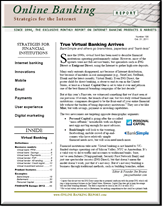 I still remember the day in early 1999 when I met with Elon Musk and his 3-person team in a borrowed conference room in Palo Alto. They were plotting the complete and total disruption of the banking industry and fully expected to be one of the largest five U.S. banks by now.
I still remember the day in early 1999 when I met with Elon Musk and his 3-person team in a borrowed conference room in Palo Alto. They were plotting the complete and total disruption of the banking industry and fully expected to be one of the largest five U.S. banks by now.
 The startup was named X.com and its original business plan was to acquire one or more existing banks to provide the credibility, and deposit insurance, of a traditional bank. While I was in awe of their ambition, I thought the plan had a flaw. I told them they’d be better off staying virtual, with no bank ownership slowing down their decision making and ability to take risks.
The startup was named X.com and its original business plan was to acquire one or more existing banks to provide the credibility, and deposit insurance, of a traditional bank. While I was in awe of their ambition, I thought the plan had a flaw. I told them they’d be better off staying virtual, with no bank ownership slowing down their decision making and ability to take risks.
I’ll never know if they would have listened to me, because soon thereafter X.com began experimenting with P2P payments via email, and they saw that it was going to be huge. So they jettisoned banking, merged with PayPal, and the rest is history.
Why the reminiscing? That was the last attempt by a major tech startup to take on the U.S. retail banking industry via virtual channels (note 1).
Fast-forward to 2011: At this year’s FinovateFall, we saw the launch of not one, but two well-funded attempts at disrupting the incumbents. One through debit/checking/savings and the other through wealth management:
- BankSimple: DNA from Twitter, analytics, and consulting
- Personal Capital : DNA from Intuit, PayPal, Everbank and Fidelity Investments
Both companies are what I call True Virtual Financial Institutions, meaning they are complete front-ends to your money, including transaction capabilities and customer service, but they outsource the actual holding of customer funds to fully-regulated partners which pass FDIC/SIPA protections. This allows the newcomers to focus on user experience and service while moving much faster without the regulatory friction experienced by traditional financial institutions.
Others well-known companies using virtual models: Betterment (also profiled in the report), iBankUp.com (Plastyc) and Perkstreet.
Note to bankers: True virtual banking needn’t be limited to tech startups. These techniques can be employed by traditional companies to expand beyond regional or industry boundaries. The report outlines seven models for doing just that.
__________________________________________________________________
About the report
__________________________________________________________________
True Virtual Banking Has Arrived (link)
BankSimple, Personal Capital, Betterment and others go branchless,
paperless and “bank-less”
Author: Jim Bruene, Editor & Founder
Published: 1 Nov 2011
Length: 48 pages
Cost: No extra charge to OBR subscribers, $395 for others here
____________________________________________________________________
Notes:
1. I should add that Lending Club, Prosper, Zopa qualify as major entrants bound on disrupting banking from the lending side.
2. BankSimple, Betterment, Personal Capital and Plastyc FinovateFall 2011 demo videos are available here.


 The startup was named X.com and its original business plan was to acquire one or more existing banks to provide the credibility, and deposit insurance, of a traditional bank. While I was in awe of their ambition, I thought the plan had a flaw. I told them they’d be better off staying virtual, with no bank ownership slowing down their decision making and ability to take risks.
The startup was named X.com and its original business plan was to acquire one or more existing banks to provide the credibility, and deposit insurance, of a traditional bank. While I was in awe of their ambition, I thought the plan had a flaw. I told them they’d be better off staying virtual, with no bank ownership slowing down their decision making and ability to take risks.





 Source: Compete.com retrieved the week of October 26, 2011
Source: Compete.com retrieved the week of October 26, 2011
